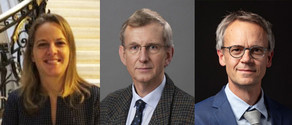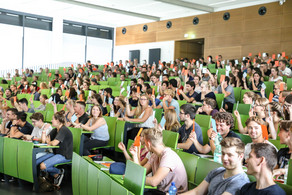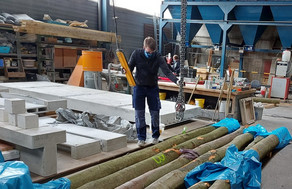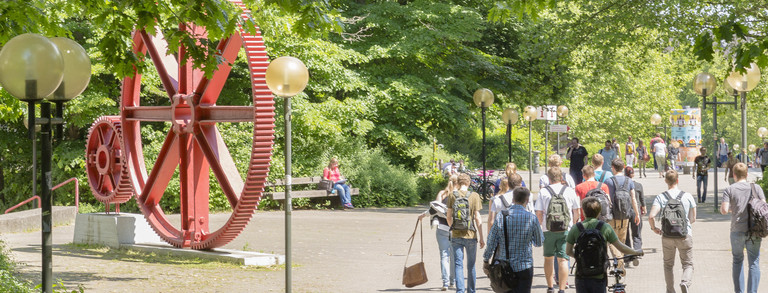Funded projects
Exploring the load-bearing behavior of wood virtually and in real life
The building sciences communicate conservation goals and sustainability measures to overcome local and global challenges in the creation and preservation of our civilization. The sensible use of wood makes an important contribution here, as wood products store carbon and improve the balance of gray emissions in construction.
In order to raise awareness of building with wood, its genesis and thus the natural load-bearing and growth behavior of trees and their resilience to adverse or damaging events are presented in a learning path. If elements of the tree structure are overloaded, damage and repair mechanisms can be observed. The latter are based on growth and mechanical principles which, in terms of bionics, point to technical reinforcement measures for the construction industry, among other things. In order to develop an awareness and expertise for sustainable construction with wood, real and virtual learning paths will present associated phenomena and in-depth knowledge of the tree as a wood-generating living being. The reference to wood as a building material and its technical properties will also be conveyed.
RecyclingStein - Characterization of lightweight concrete blocks made from recycled material using non-destructive testing methods
The carbon footprint of lightweight concrete is clearly superior to that of other masonry materials such as bricks or traditional concrete. Transferring the resources used into a circular economy without downcycling would further improve theCO2 balance of lightweight concrete blocks, avoid waste and counteract the scarcity of resources.
The aim of the project is to develop a new type of lightweight concrete with a grain size of up to 100% recycled material (RC material), while achieving the same compressive strength and bulk density as conventional lightweight concrete. This new type of lightweight concrete is to be used primarily for lightweight concrete blocks in masonry construction, but also for building panels, for example. For this purpose, formulations consisting of grain size, cement matrix and water as well as corresponding manufacturing processes are being developed.
In order to guarantee the stability of lightweight concrete blocks (LBS) made from these, for example, despite the sometimes high quality differences in the demolition material used, an innovative non-destructive testing method (NDT) is to be developed to check the blocks for flaws and other defects. For this purpose, a method based on ultrasound technology is to be developed for use on highly porous lightweight concrete. In addition, a novel evaluation algorithm based on machine learning (ML) is to be developed to evaluate the highly complex measurement signals to be expected here, which automatically recognizes correlations in the measurement signal and uses this to draw conclusions about the internal stone structure.
This project is being carried out in cooperation with: Chair of Materials in Civil Engineering at TU Dortmund University, Jakob Stockschländer GmbH & Co. KG, SVTI Swiss Association for Technical Inspections
Adaptive Learning Environment in Dynamics as OER - ALFDYN
The TU Dortmund University, TH Köln, University of Duisburg-Essen, RWTH Aachen University and the Ruhr West University of Applied Sciences have joined forces for the ALFDYN project in order to provide students with more targeted support in their learning process in the subject of dynamics. The partners have set themselves the goal of designing a learning environment that enables individual teaching and learning processes. This implies that first of all a correspondingly broad selection of different learning formats is generated in order to be able to serve personal needs at all.
However, individualisation also means that a diagnosis of learning barriers and learning behaviour is necessary, for which students must of course be ready. But this is where the project is particularly exciting and important, because we need new tools, especially in the area of digital teaching, to get interaction between the provision and use of teaching material. To this end, we propose that students first assess themselves in terms of motivation and level of knowledge and that the learning platform subsequently offers and analyses self-tests again and again in order to suggest the next learning step. In addition, the platform will request feedback on the formats in order to be able to develop them further. The diagnostic tool will not be a prerequisite for using the content - access is independent of it. However, those who use the diagnosis and interaction will also contribute to the improvement of the teaching processes.
META-LEGO
META-LEGO will bring the knowledge needed to design metamaterials/classical-materials structures that control elastic waves and recover energy. For this, we will develop, implement and validate a new paradigm for finite-size metamaterials’ modeling, by leveraging the relaxed-micromorphic model that we have contributed to pioneer.
The presence of boundaries in metamaterials strongly affects their response when coming in contact with mechanical loads. Yet, we still lack an exhaustive model to predict the static/dynamic response of finite-size metamaterials: current homogenization methods are unsuitable to provide a coherent transition from infinite- to finite-size metamaterials modeling. This prevents us from exploring realistic structures combining metamaterials’ and classical-materials’ bricks of finite size.
META-LEGO hypothesizes that the mechanical response of finite-size metamaterials can be explored going beyond classical homogenization. Instead, we will create an elastic- and inertia-augmented micromorphic model with embedded internal lengths to describe the main metamaterials’ fingerprint characteristics, such as anisotropy, dispersion, band-gaps, size-effects, etc.
The reduced model’s structure (free of unnecessary parameters), coupled with well-posed boundary conditions, will allow us to unveil the static/dynamic response of both real and not-yet-existing metamaterials’ bricks of arbitrary size and shape. Playing LEGO with such bricks, we will be able to design and optimize surprising meta-structures, such as noise- and vibration-controlled railway stations, or meta-cities entirely protected from seismic waves.
Organic Tiny Houses
The project develops Tiny Houses, which mainly use spruce wood from local forests as building material. The modular construction allows for residential and commercial use and allows for subsequent expansion. Within the consortium, the TU Dortmund University working group is responsible for technical and planning tasks with an emphasis on sustainability considerations. This includes, among other things, the saving of resources during construction as well as the preservation of material cycles. The focus is on ecological and contemporary construction methods as well as compliance with the highest standards in thermal insulation, structural design and load-bearing safety. This ensures long life cycles, enables repurposing and ultimately deconstruction as well as the reuse of raw materials. The project also aims to develop additional innovations for the targeted construction method. This includes, among other things, the coordination of parameters with an online configurator as well as a holistic design of the room modules. All work objectives will be supported and evaluated by the construction of prototypes. The overall concept serves the primary goal of creating living space through efficient timber construction and thus creating value to enable the reforestation of areas deforested by the bark beetle through the sale of the product "Organic Tiny House".
Digital learning environment - structural engineering - as a holistic concept
The aim of the project is a digital learning environment for students of civil engineering in the basic subject of structural analysis. In order to improve studyability, digital formats should offer students a receiving, reactive role or an independent, active role depending on their needs. The digital formats teaser, screencast, videotaped experiment, training tool, virtual lab, and inverted classroom can be used autonomously or within face-to-face courses. The offering is intended to integrate both institutionally and with individual learning behaviors, so intrinsic value is complemented by countable value for students. To achieve this, the applicants commit to aligned learning objectives and content as well as common assessment requirements and forms in terms of Constructive Alignment. The holistic concept of the digital learning environment should enrich the personal learning environment and also generate individual support.
Project description on e-teaching.org
Topology and shape optimization of inclusions in multi-material structureson Form und Topologie
In material research new multi material structures are developed. Often its desired load bearing capacity and behavior can be achieved by optimizing the distribution of the inclusions in a matrix material. Generally traction in-between matrix material and inclusion needs to be limited in order to avoid local damage.
In the context of our project this class of optimization problem is solved with a mathematically based gradient method. For example the maximization of stiffness/density-ratio while controlling the stresses and strains at boundaries and modification of the amount, location and shape of inclusions is treated.
The implizit geometric description of several inclusions is based on level set functions. Jumps in the strain field at boundaries between matrix material and inclusion are modeled by amplification of FEM for instance as applied in the extended finite element method. Additional approaches, e.g. suitably shape functions or adaptive FE-methods ensure the calculation of reliable stresses on internal boundaries.
Object of our work is to quantify the sensitivity of the structural response related to variation of shape and material of the inclusions and therefor make it accessible for evaluation. Furthermore the development of an robust optimization algorithm for automatic topological and shape optimization of inclusions in multi-material structures is intended.
Structural optimization based on a singular value decomposition of the sensitivities
The internal structure of the sensitivities of engineering structures with respect to modifications in shape shall be analysed both qualitatively and quantitatively using the singular value decomposition (SVD). The term internal structure of sensitivity is introduced as an abbreviation for the eigenvalues (EW) and singular values (SW), the corresponding eigenvalue spectrum and singular value spectrum as well as for the associated eigenvectors (EV) and singular vectors (SV) of the mesh velocity matrix, the stiffness matrix, the pseudo load matrix and the sensitivity matrix, which build up the central parts of the sensitivity analysis. The goal of the project can be stated as follows.
The impact of the chosen model on the computed optimal design, especially the influence of the chosen FEM and CAGD approximations, shall be analysed. The weaknesses of the model shall be improved by using appropriate finite element models and an optimised regularisation. The quantitative results shall be postprocessed and visualised to ease a qualitative review of the optimisation model by the engineer. An automatic strategy for the adaptive modification of the geometry model used for optimisation shall be developed and tested.
The project concentrates on static structural analysis and on linear and nonlinear hyperelastic material behaviour. The extension to dynamic analysis and inelastic material behaviour is postponed to a subsequent project.





